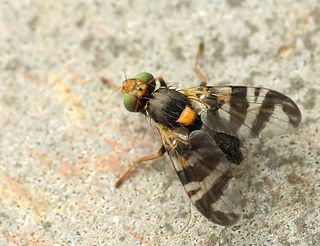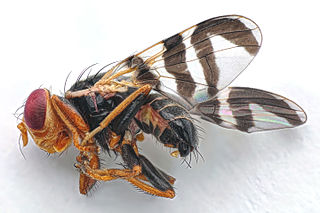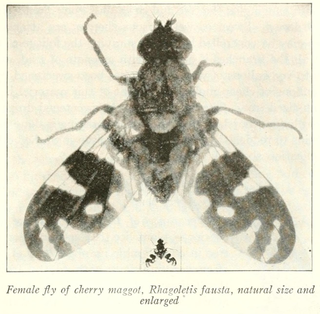
A maggot is the larva of a fly ; it is applied in particular to the larvae of Brachycera flies, such as houseflies, cheese flies, and blowflies, rather than larvae of the Nematocera, such as mosquitoes and Crane flies. A 2012 study estimated the population of maggots in North America alone to be in excess of 3×1017.

The apple maggot, also known as the railroad worm, is a species of fruit fly, and a pest of several types of fruits, mainly apples. This species evolved about 150 years ago through a sympatric shift from the native host hawthorn to the domesticated apple species Malus domestica in the northeastern United States. This fly is believed to have been accidentally spread to the western United States from the endemic eastern United States region through contaminated apples at multiple points throughout the 20th century. The apple maggot uses Batesian mimicry as a method of defense, with coloration resembling that of the forelegs and pedipalps of a jumping spider.

Juglans nigra, the eastern American black walnut, is a species of deciduous tree in the walnut family, Juglandaceae, native to North America. It grows mostly in riparian zones, from southern Ontario, west to southeast South Dakota, south to Georgia, northern Florida and southwest to central Texas. Wild trees in the upper Ottawa Valley may be an isolated native population or may have derived from planted trees.

Juglans regia, the Persian walnut, English walnut, Carpathian walnut, Madeira walnut, or especially in Great Britain, common walnut, is an Old World walnut tree species native to the region stretching from the Balkans eastward to the Himalayas and southwest China. It is widely cultivated across Europe.

The Tephritidae are one of two fly families referred to as fruit flies, the other family being the Drosophilidae. The family Tephritidae does not include the biological model organisms of the genus Drosophila, which is often called the "common fruit fly". Nearly 5,000 described species of tephritid fruit fly are categorized in almost 500 genera of the Tephritidae. Description, recategorization, and genetic analyses are constantly changing the taxonomy of this family. To distinguish them from the Drosophilidae, the Tephritidae are sometimes called peacock flies, in reference to their elaborate and colorful markings. The name comes from the Greek τεφρος, tephros, meaning "ash grey". They are found in all the biogeographic realms.
The Lonicera fly, a hybrid in the genus Rhagoletis, is a North American fruit fly of the family Tephritidae. Its larvae feed on the berries of species of introduced honeysuckle (Lonicera) that were brought to America within the last 250 years as ornamental plants. A research team led by Dietmar Schwarz has argued that it most likely developed within that time by hybridization of two other species: R. mendax, the blueberry maggot, and R. zephyria, the snowberry maggot. Few cases of animal species arising from hybridization are known, although with DNA analysis more are being found.
Superparasitism is a form of parasitism in which the host is attacked more than once by a single species of parasitoid. Multiparasitism or coinfection, on the other hand, occurs when the host has been parasitized by more than one species. Host discrimination, whereby parasitoids can identify a host with parasites from an unparasitized host, is present in certain species of parasitoids and is used to avoid superparasitism and thus competition from other parasites. Superparasitism can result in transmission of viruses, and viruses may influence a parasitoid's behavior in favor of infecting already infected hosts, as is the case with Leptopilina boulardi.
Diachasmimorpha mellea is a species of braconid parasitoid wasp which attacks multiple species of Rhagoletis fruit flies, including R. pomonella, the apple maggot fly. This wasp has been found throughout much of the United States and in Central Mexico. It is morphologically similar to and has overlapping range with another apple maggot parasitoid, Diachasma alloeum.

Rhagoletis is a genus of tephritid fruit flies with about 70 species.

Rhagoletis mendax is a species of tephritid fruit fly known by the common name blueberry maggot. The blueberry maggot is closely related to the apple maggot, a larger fruit fly in the same genus. It is a major pest of plant species in the Ericaceae family, such as blueberry, cranberry, and huckleberry. The larva is 5 to 8 mm long, apodous, and white with chewing mouthparts. Female adults are 4.75mm in length, males are slightly smaller. Both adults are mostly black in color with white stripes, orange-red eyes, and a single pair of clear wings with black banding. The adult female fly lays a single egg per blueberry, and when the larva hatches it consumes the fruit, usually finishing the entire berry in under 3 weeks and rendering it unmarketable. The larva then falls to the soil and pupates. Adult flies emerge, mate, and females oviposit when blueberry plants are producing fruit. Each female fly can lay 25 to 100 eggs in their lifetime.

Rhagoletis cerasi is a species of fruit fly in the family Tephritidae.

Juglans hindsii, commonly called the Northern California walnut and Hinds' black walnut, is a species of walnut tree endemic to Northern California. It is commonly called claro walnut by the lumber industry and woodworkers, and is the subject of some confusion over its being the root stock for English walnut orchard stock.

Rhagoletis batava is a species of tephritid or fruit flies in the genus Rhagoletis of the family Tephritidae. Rhagoletis batava larvae feed inside fruit flesh, and can be important pest of seabuckthorn. This species is very similar to Rhagoletis cerasi

Rhagoletis fausta, the black-bodied cherry fruit fly, is a species of tephritid or fruit flies in the genus Rhagoletis of the family Tephritidae. It is found in the United States and Canada.
Rhagoletis juglandis, also known as the walnut husk fly, is a species of tephritid or fruit fly in the family Tephritidae. It is closely related to the walnut husk maggot Rhagoletis suavis. This species of fly belongs to the R. suavis group, which has a natural history consistent with allopatric speciation. The flies belonging to this group are morphologically distinguishable.
Rhagoletis ochraspis is a species of tephritid or fruit fly in the genus Rhagoletis of the family Tephritidae.
The eastern cherry fruit fly, Rhagoletis cingulata, is a species of tephritid or fruit flies in the genus Rhagoletis of the family Tephritidae. The cherry fruit fly, Rhagoletis cingulata (Loew), is found from Michigan to New Hampshire, southward to Florida, occurring over the entire middle and eastern region of the United States and also in southeastern and southcentral Canada.

Rhagoletis meigenii, common name Barberry Fly or Yellow Berberis Fruit Fly, is a species of tephritid or fruit flies in the genus Rhagoletis of the family Tephritidae.
Ronald John Prokopy was an American entomologist who was a specialist on the behavior and biology of Rhagoletis flies and approaches to their management in apple orchards.











